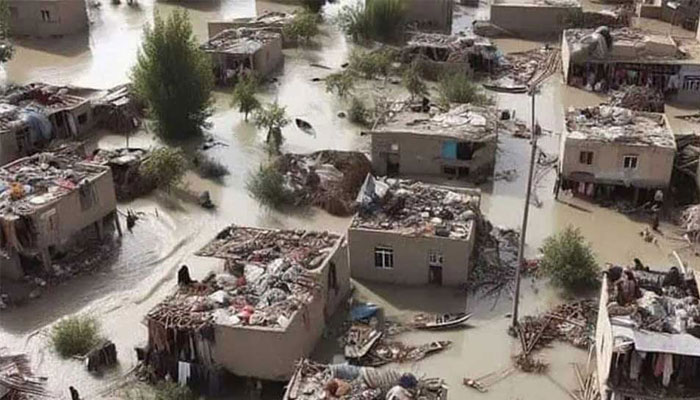Rains turn deadly as Pakistan faces worsening climate change
Pakistan faces deadly cloudbursts and floods, exposing fragile infrastructure and an urgent need for climate resilience reforms.
GB-KP-(Mudasser Iqbal)-The rains came without warning, as they often do these days. One moment, the skies over Swat were merely overcast; the next, they unleashed a fury that swept away homes, roads, and lives with equal indifference. This is the new reality of Pakistan’s relationship with weather: unpredictable, violent, and increasingly deadly.
Cloudbursts, those sudden torrential downpours that dump more than 100 millimetres of rain in a single hour, have become the unwelcome guests of our changing climate. They arrive unannounced, wreak havoc, and leave behind devastation that takes months, sometimes years, to repair.
But perhaps what’s most troubling is how we’ve begun to accept them as just another part of Pakistani life, like power outages or traffic jams: inconvenient but inevitable.
Recent weeks have been particularly brutal. Sudden floods triggered by heavy rains have killed more than 200 people across parts of Pakistan, Indian-administered Kashmir, and Nepal, turning the evening news into a grim accounting of lives lost and communities destroyed. The images are always the same: muddy water rushing through streets that were dry hours earlier, people clinging to rooftops, rescue workers pulling bodies from debris that was once someone’s home.
What makes these events particularly heartbreaking is their predictability within unpredictability. We know they will come; we just don’t know when or where. This is climate change in its most visceral form—not the abstract warming of global temperature charts, but the immediate, life-threatening reality of water where it shouldn’t be, when it shouldn’t be there.
Meanwhile, our cities have been preparing for the wrong kind of future. Karachi, Lahore, and Islamabad have all grown upward and outward without adequately considering what happens when the skies open up. Concrete has replaced the earth that once absorbed rainfall naturally. Drainage systems designed for a gentler climate struggle with the violent downpours that are becoming routine. We’ve built cities that work beautifully until it rains, and then they don’t work at all.
The failure isn’t just in our infrastructure; it’s in our thinking. For too long, we’ve approached disasters as one-off emergencies rather than symptoms of a larger problem that require fundamental changes in how we live, build, and plan. The Pakistan Meteorological Department issues warnings, but what good are warnings if people in remote valleys have no way to receive them, or if they do receive them, have nowhere safe to go?
Pakistan Stock Exchange crosses 151,000 milestone, sets record
This institutional failure runs deep. Disaster management in Pakistan resembles a dysfunctional family: everyone has opinions, but no one wants to take responsibility. Responsibilities are scattered across multiple agencies and levels of government, creating a system where everyone is in charge and no one is accountable. When the floods come, the response is predictable: finger-pointing, blame games, and promises that next time will be different.
Yet money alone won’t solve this crisis. We need to fundamentally rethink how we relate to our environment and our future. The early warning systems need to reach every village, every neighbourhood, and every person who might find themselves in harm’s way. This means investing not just in technology but in the human networks that can translate warnings into action.
Building codes need to be more than suggestions politely ignored by developers. They need to be enforced with the kind of rigour we apply to VIP security arrangements. Every new construction should be required to prove it can handle the kind of weather we’re already seeing, not the mild climate we remember from decades past.
The private sector has been notably absent from serious climate adaptation discussions, treating environmental concerns as corporate social responsibility rather than business survival strategy. Education, too, needs a complete overhaul. Children should learn about climate change not as a distant possibility but as a present reality that will shape their entire lives. They need to understand both the science behind what’s happening and the practical skills for living in a climate-changed world.
Regional cooperation offers some hope. Weather systems don’t respect borders, and neither should our response to them. Sharing meteorological data with India, Afghanistan, China, and Iran could improve forecasting for everyone. Joint disaster response protocols could save lives and reduce duplication of effort.
Traditional solutions are proving inadequate for non-traditional problems. Instead of just building bigger dams and higher walls, we need to work with nature rather than against it. Restoring forests, protecting wetlands, and designing cities that can breathe when the rains come—these approaches recognise that we’re part of the environment, not separate from it.
Technology offers tools that previous generations couldn’t imagine. Artificial intelligence can improve weather forecasting. Mobile phones can deliver warnings to the remotest villages. What’s needed now is not another committee or another study, but a fundamental shift in national priorities. Climate adaptation needs to be treated with the same urgency we reserve for national security threats, because that’s exactly what it is. The cloudbursts aren’t going to stop while we figure out the perfect policy response.
The choice facing Pakistan is stark but simple: continue treating climate disasters as unfortunate exceptions to normal life, or recognise that they are normal life now and plan accordingly. The rains will keep coming, probably with increasing frequency and intensity. The question is whether we’ll be ready for them, or whether we’ll keep being surprised by what we should have seen coming.
Excellent performance of Mohsin Naqvi as Interior Minister
The cloudbursts are not just meteorological events; they are messages from a future that has already arrived. How we respond to them will determine not just how many people survive the next flood, but what kind of country our children inherit. The time for half-measures and wishful thinking has passed. What remains is the harder work of actually changing how we live on this earth, in this climate, with these risks that are no longer theoretical but terrifyingly real.
BY: MUHAMMAD ISHAQ HASHMI






Comments are closed, but trackbacks and pingbacks are open.